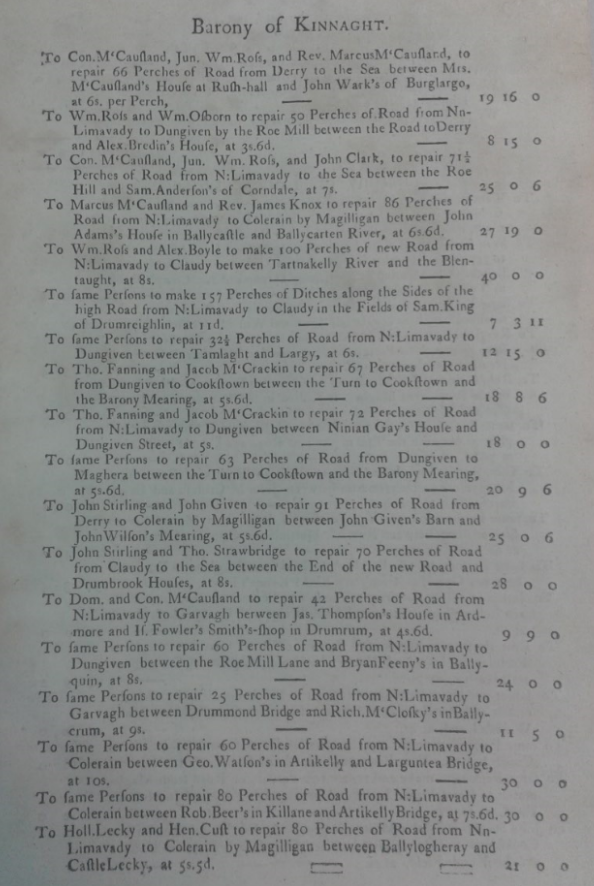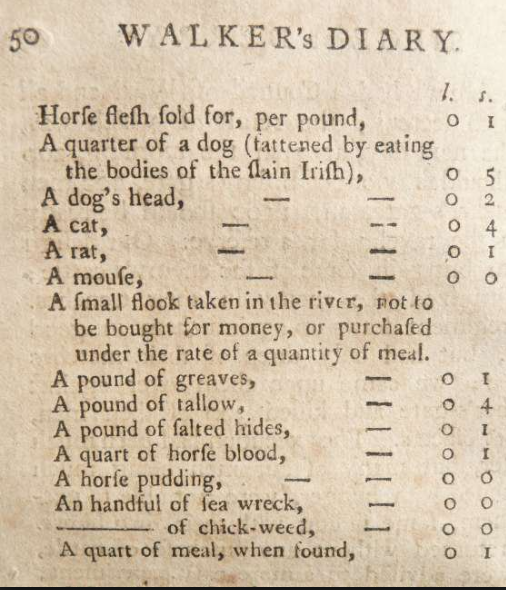Grand Jury records - boringly good?
Grand Jury records - boringly good?
In 1765 an act of parliament transferred the responsibility of maintaining major roads to the county grand jury. Grand juries were also allowed to finance road building by being able to impose a county-cess. Later an act was passed permitting parishes to raise an extra tax to maintain minor roads, while an Act for the making of narrow roads through the mountainous unimproved parts of this kingdom permitted grand juries to raise money for this purpose also. The result of this legislation was a dramatic increase in the number of miles of road in the province, so that by 1800 Ulster had one of the densest road networks in Western Europe.The grand jury was selected by the high sheriff from the leading property owners in the county. Its membership was almost exclusively Protestant and was often chosen from a limited group of well-connected families. Catholics were forbidden to serve until 1793.
Surviving grand jury records PRONI
CO ANTRIM
Presentment books, 1711–21, 1727–67, 1775–84, 1796–1804 – ANT4/1/1–7
Grand warrant books: baronies of Upper and Lower Antrim, 1776–93, 1794–1804 – ANT4/2/1/1–2 Grand warrant books: baronies of Upper and Lower Dunluce, 1776–92, 1792–1804 – ANT4/2/2/1–2 Grand warrant books: baronies of Kilconway and Cary, 1776–92, 1793–1804 – ANT4/2/3/1–2
Grand warrant books: baronies of Upper & Lower Massareene 1776–92, 1792–1804 – ANT4/2/4/1-2
Grand warrant books: baronies of Upper and Lower Belfast, 1775–92, 1792–1804 – ANT4/2/5/1–2
Grand warrant books: baronies of Upper and Lower Glenarm, 1776–94, 1794–1816 – ANT4/2/6/1–2
Grand warrant book: baronies of Upper and Lower Toome, 1791–1804 – ANT4/2/7/1
Grand warrant book: Carrickfergus, 1766–1817 – ANT/4/2/8/1 \
Printed presentment book, 1778–1800 –ANT4/4/1
Grand Jury resolution book with account, 1780–1824 – ANT4/7/1
CO ARMAGH
Grand Jury lists, 1735–97 – T647
Extracts from Grand Jury records, 1735–75, providing names of prosecutors, persons indicted and reason; lists of jurors, 1735–98 – T636/1, pp. 85–100
Presentment books, beginning in 1758 – ARM4/1 Presentment book, 1790 – D288/1
CO DONEGAL
Jury presentments, baronies of Boylagh and Banagh, 1772, 1784–98 MIC352/1
CO DOWN
Presentment books, beginning in 1778 – DOW4/2
Grand Jury record books, beginning in 1780 – DOW4/4
Register of trees planted, 1769–99 – DOW7/3/2/1
Presentments at assizes, 1714–96 – T808/15015
CO FERMANAGH
Presentment book for the county at large, 1792–1819 – FER4/3/1
Criminal book, county assizes, 1792–1861 – FER4/8/1
CO L'DERRY
Presentment books, beginning in 1788 – LOND4/1
Register of trees planted, 1773–1894 – LOND7/7/1
CO TYRONE
Presentment books, beginning in 1799 – TYR4/1
Grand Jury indictment book, 1745–1809 - TYR4/2/1. This gives the names of prosecutors, the names of the persons indicted, the offence and the finding of the Grand Jury. The book is badly damaged.
GRAND JURY RECORDS
The Grand Jury records are an important source for the local historian as they note the development of the infrastructure on townland, parish and baronial lines. They also include the names of many local people as often houses and farms were listed as markers for the building or repair of roads in rural areas. Unfortunately, they are relatively boring to read as they contain long lists of road building and road repairs but they can be valuable for the genealogist and local historian alike. Two examples are outlined below.
LOND4/1/1 Presentment books L'Derry
Barony of Keenaght
Lent 1789
To Marcus McCausland, the Rev James Knox & Conolly McCausland to repair 68 perches of road from N'Limavady to Coleraine by Magilligan between Thomas Caldwell's and John Sinyard's house at 7s per. Total 21-0-0
Summer 1795
To Con. McCausland, John Stirling & Marcus Gage to build a bridge over the river Roe between Ballymaglin & Bellyrena (Bellerena) Total 100 pounds
In 1765 an act of parliament transferred the responsibility of maintaining major roads to the county grand jury. Grand juries were also allowed to finance road building by being able to impose a county-cess. Later an act was passed permitting parishes to raise an extra tax to maintain minor roads, while an Act for the making of narrow roads through the mountainous unimproved parts of this kingdom permitted grand juries to raise money for this purpose also. The result of this legislation was a dramatic increase in the number of miles of road in the province, so that by 1800 Ulster had one of the densest road networks in Western Europe.The grand jury was selected by the high sheriff from the leading property owners in the county. Its membership was almost exclusively Protestant and was often chosen from a limited group of well-connected families. Catholics were forbidden to serve until 1793.
 |
| Presentment book Barony of Keenaght 1788 |
CO ANTRIM
Presentment books, 1711–21, 1727–67, 1775–84, 1796–1804 – ANT4/1/1–7
Grand warrant books: baronies of Upper and Lower Antrim, 1776–93, 1794–1804 – ANT4/2/1/1–2 Grand warrant books: baronies of Upper and Lower Dunluce, 1776–92, 1792–1804 – ANT4/2/2/1–2 Grand warrant books: baronies of Kilconway and Cary, 1776–92, 1793–1804 – ANT4/2/3/1–2
Grand warrant books: baronies of Upper & Lower Massareene 1776–92, 1792–1804 – ANT4/2/4/1-2
Grand warrant books: baronies of Upper and Lower Belfast, 1775–92, 1792–1804 – ANT4/2/5/1–2
Grand warrant books: baronies of Upper and Lower Glenarm, 1776–94, 1794–1816 – ANT4/2/6/1–2
Grand warrant book: baronies of Upper and Lower Toome, 1791–1804 – ANT4/2/7/1
Grand warrant book: Carrickfergus, 1766–1817 – ANT/4/2/8/1 \
Printed presentment book, 1778–1800 –ANT4/4/1
Grand Jury resolution book with account, 1780–1824 – ANT4/7/1
CO ARMAGH
Grand Jury lists, 1735–97 – T647
Extracts from Grand Jury records, 1735–75, providing names of prosecutors, persons indicted and reason; lists of jurors, 1735–98 – T636/1, pp. 85–100
Presentment books, beginning in 1758 – ARM4/1 Presentment book, 1790 – D288/1
CO DONEGAL
Jury presentments, baronies of Boylagh and Banagh, 1772, 1784–98 MIC352/1
CO DOWN
Presentment books, beginning in 1778 – DOW4/2
Grand Jury record books, beginning in 1780 – DOW4/4
Register of trees planted, 1769–99 – DOW7/3/2/1
Presentments at assizes, 1714–96 – T808/15015
CO FERMANAGH
Presentment book for the county at large, 1792–1819 – FER4/3/1
Criminal book, county assizes, 1792–1861 – FER4/8/1
CO L'DERRY
Presentment books, beginning in 1788 – LOND4/1
Register of trees planted, 1773–1894 – LOND7/7/1
CO TYRONE
Presentment books, beginning in 1799 – TYR4/1
Grand Jury indictment book, 1745–1809 - TYR4/2/1. This gives the names of prosecutors, the names of the persons indicted, the offence and the finding of the Grand Jury. The book is badly damaged.
GRAND JURY RECORDS
The Grand Jury records are an important source for the local historian as they note the development of the infrastructure on townland, parish and baronial lines. They also include the names of many local people as often houses and farms were listed as markers for the building or repair of roads in rural areas. Unfortunately, they are relatively boring to read as they contain long lists of road building and road repairs but they can be valuable for the genealogist and local historian alike. Two examples are outlined below.
ANT/4/2/8/1 Carrickfergus Grant Warrant
Book 1766-1817
From the warrant book for Carrickfergus we learn the location of Ezekiel Milliken's house about 170 meters from Ballock Hall bridge (one perch is equivalent to 5 metres). We also learn that Ezekiel was a glazier by trade and fitted window panes to the Court House and Jury Room in 1813.
Lent Assizes 1809
No.5 We present the sum of £6-7-5 to be
levied as above & paid Mr John Legg, Mr Daragh & Alex’r Donaldson to
repair 28 perches of road beginning at Ezek’l Milliken’s house & ending at
Mr Legg’s in the Scotch Quarter road leading from Carrickfergus to Larne.
Lent Assizes 1813
No 11. We present the sum of 5sh, 7 pence
stg be rassed [raised] off the County & paid to Ezekal Milekan for Glazing
sundry pains in the Court House & Jury Room.
Lent Assizes 1817
We present the sum of £8-18sh, 8d stg to be
raised off this county & paid to John Legg Esq, Sir Wm Kirk & Alex’r
Donaldson to repair 34 perches of road from C’Fergus to Larne at sundry places
commencing at the little bridge near Ballock Hall and ending at Eze’l
Millikin’s house being at the rate of 5sh per perch including 8sh, 6d overseers
wages.
The second example from the present book containing the barony of Keenaght (Limavady) contains a reference to a John Sinyard residing in the parish of Magilligan. Sinyard appears to have worked on the Gage estate and is also listed in the presentment book as a sub-constable for the barony of Keenaght. In addition we find that a new bridge was built across the river Roe at Bellerena for the princely sum of 100 pounds paid to local gentry Conolly McCausland, John Stirling and Marcus Gage. These three men were local landlords - Marcus Gage and Conolly McCausland were actually brothers. Marcus took the name Gage in order to inherit the Gage estate in Magilligan inherited by his mother Elizabeth Gage McCausland from her brother Hodgson Gage. Marcus Gage married Julia Stirling in 1788.
Barony of Keenaght
Lent 1789
To Marcus McCausland, the Rev James Knox & Conolly McCausland to repair 68 perches of road from N'Limavady to Coleraine by Magilligan between Thomas Caldwell's and John Sinyard's house at 7s per. Total 21-0-0
Summer 1795
To Con. McCausland, John Stirling & Marcus Gage to build a bridge over the river Roe between Ballymaglin & Bellyrena (Bellerena) Total 100 pounds
 |
| Bellerena Bridge |



Comments
Post a Comment